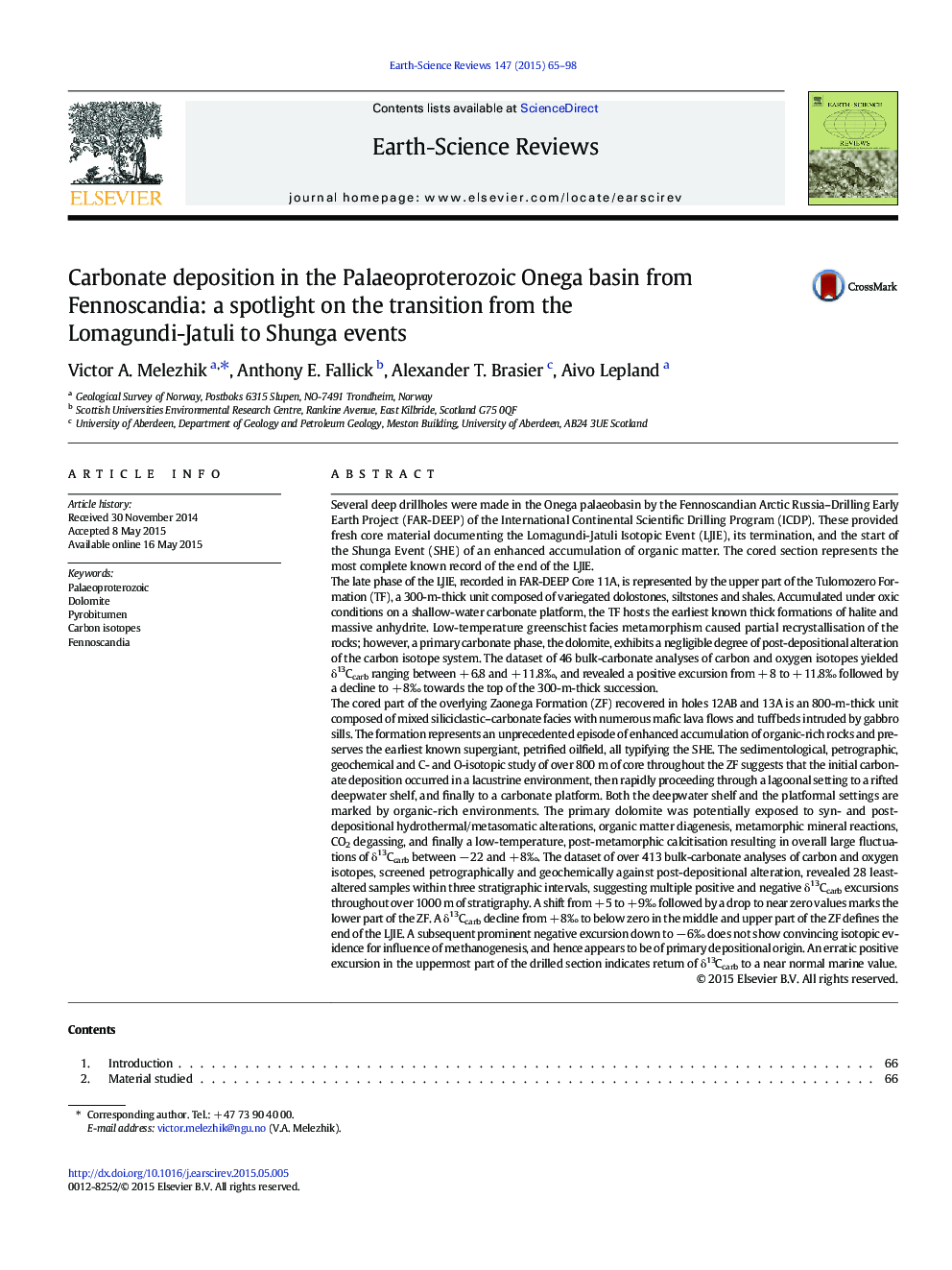| کد مقاله | کد نشریه | سال انتشار | مقاله انگلیسی | نسخه تمام متن |
|---|---|---|---|---|
| 4725710 | 1639955 | 2015 | 34 صفحه PDF | دانلود رایگان |

Several deep drillholes were made in the Onega palaeobasin by the Fennoscandian Arctic Russia–Drilling Early Earth Project (FAR-DEEP) of the International Continental Scientific Drilling Program (ICDP). These provided fresh core material documenting the Lomagundi-Jatuli Isotopic Event (LJIE), its termination, and the start of the Shunga Event (SHE) of an enhanced accumulation of organic matter. The cored section represents the most complete known record of the end of the LJIE.The late phase of the LJIE, recorded in FAR-DEEP Core 11A, is represented by the upper part of the Tulomozero Formation (TF), a 300-m-thick unit composed of variegated dolostones, siltstones and shales. Accumulated under oxic conditions on a shallow-water carbonate platform, the TF hosts the earliest known thick formations of halite and massive anhydrite. Low-temperature greenschist facies metamorphism caused partial recrystallisation of the rocks; however, a primary carbonate phase, the dolomite, exhibits a negligible degree of post-depositional alteration of the carbon isotope system. The dataset of 46 bulk-carbonate analyses of carbon and oxygen isotopes yielded δ13Ccarb ranging between + 6.8 and + 11.8‰, and revealed a positive excursion from + 8 to + 11.8‰ followed by a decline to + 8‰ towards the top of the 300-m-thick succession.The cored part of the overlying Zaonega Formation (ZF) recovered in holes 12AB and 13A is an 800-m-thick unit composed of mixed siliciclastic–carbonate facies with numerous mafic lava flows and tuff beds intruded by gabbro sills. The formation represents an unprecedented episode of enhanced accumulation of organic-rich rocks and preserves the earliest known supergiant, petrified oilfield, all typifying the SHE. The sedimentological, petrographic, geochemical and C- and O-isotopic study of over 800 m of core throughout the ZF suggests that the initial carbonate deposition occurred in a lacustrine environment, then rapidly proceeding through a lagoonal setting to a rifted deepwater shelf, and finally to a carbonate platform. Both the deepwater shelf and the platformal settings are marked by organic-rich environments. The primary dolomite was potentially exposed to syn- and post-depositional hydrothermal/metasomatic alterations, organic matter diagenesis, metamorphic mineral reactions, CO2 degassing, and finally a low-temperature, post-metamorphic calcitisation resulting in overall large fluctuations of δ13Ccarb between − 22 and + 8‰. The dataset of over 413 bulk-carbonate analyses of carbon and oxygen isotopes, screened petrographically and geochemically against post-depositional alteration, revealed 28 least-altered samples within three stratigraphic intervals, suggesting multiple positive and negative δ13Ccarb excursions throughout over 1000 m of stratigraphy. A shift from + 5 to + 9‰ followed by a drop to near zero values marks the lower part of the ZF. A δ13Ccarb decline from + 8‰ to below zero in the middle and upper part of the ZF defines the end of the LJIE. A subsequent prominent negative excursion down to − 6‰ does not show convincing isotopic evidence for influence of methanogenesis, and hence appears to be of primary depositional origin. An erratic positive excursion in the uppermost part of the drilled section indicates return of δ13Ccarb to a near normal marine value.
Journal: Earth-Science Reviews - Volume 147, August 2015, Pages 65–98